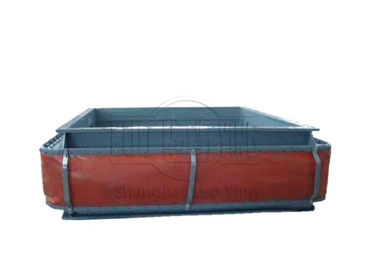What is the material of non-metallic expansion joint? What are the properties?
Jan-23-25
None of the non-metallic expansion joint metals have any of the metallurgical defects that cause weld cracking. The amount of ferrite in the weld metal (3.9/%) exceeds the normal ferrite content for interdendritic cracking (thermal and microcracking). The residual stress value of 82.10 MPa in the tube of 304 non-metallic expansion joint pipe is not too high, however, when the weld metal is cooled from the solid phase line to approximately 982°C, the stress to which the weld metal is subjected should be reduced to small in this temperature range, because in this temperature range Weld metal to microcrack for, and in some dendritic structures found on the surface of the oxide, indicating that the crack large may be formed at high temperatures, the presence of elements in the crack found in the inspection of aluminum, calcium, silicon and magnesium is likely to be due to 304 non-metallic expansion joint tube cracking after contamination caused by.Mechanical equipment method than the hydraulic machine method, machine equipment is simple and the rate is a little higher, so at this stage in the specific use of more common. Especially in the very few large diameter straight seam non-metallic expansion joint system pipe expansion process is chosen. In the non-metallic expansion joint products by the expansion of the entire process of production and processing, the key can be divided into five links. Non-metallic expansion joints open until all non-metallic expansion joints are touching the non-metallic expansion joint internal cavity, at this time the step range of non-metallic expansion joints in the inner circle of steel pipe in the size of the radius of all points are basically the same, non-metallic expansion joints to obtain the basic whole circle. The second is for the name of the inner diameter link: non-metallic expansion joints in the past section parts gradually reduce the rate of fitness movement until they reach the prescribed part, this part is the quality of the manufactured tube in the round on the part.
The non-metallic expansion joint of the non-metallic expansion joint may slowly rate reduction until it reaches the prescribed part, this part is the process technology provisions of the bullet recovery before the non-metallic expansion joint of the inner circle on the part. The non-metallic expansion joint is maintained for a period of time without movement in the upper part of the inner circle of the non-metallic expansion joint before the bullet recovery, which is a smooth link of pressure-holding stipulated by the machinery and equipment and the expansion process. The non-metallic expansion joint from the bullet before the non-metallic expansion joint on the round part of the continuous development of contraction, straight eventually will do the original expansion of the part, it is the expansion process provisions of the non-metallic expansion joint small closing diameter. In the specific application, the processing process simplification in the process can be combined with simplification, which has no impact on the expansion quality of non-metallic expansion joints.
If the non-metallic expansion joint's is generally lower than the 201 material on the market, it should be carefully identified, which is likely to be counterfeited by other materials. Confirm that the steel sealing material "non-metallic expansion joint" is embossed on the surface of the pipe and ask the manufacturer to provide proof of quality. Acid reagents can be used for testing. 30 seconds later, the non-metallic expansion joint does not change color and becomes a qualified product. Rolled pipes usually have internal double skin, pockmarks and rolled green lines. Under normal circumstances, these are unavoidable and basically do not affect the use. The hardness of non-metallic expansion joints increases with time, which is called age hardening. The aging phenomenon not only means hardening, hardness and strength are the characteristics of non-metallic expansion joints, so we call it age hardening. Due to age hardening, the invention of hard aluminum alloys can only be used.


